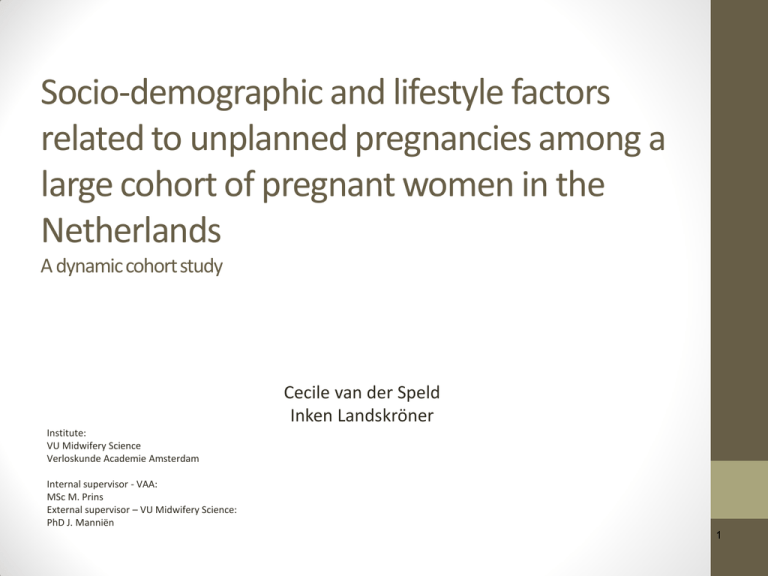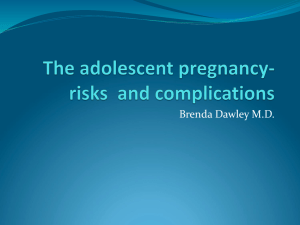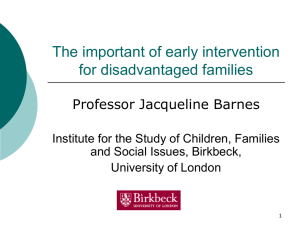Unplanned pregnancies - Kennispoort Verloskunde
advertisement

Socio-demographic and lifestyle factors related to unplanned pregnancies among a large cohort of pregnant women in the Netherlands A dynamic cohort study Cecile van der Speld Inken Landskröner Institute: VU Midwifery Science Verloskunde Academie Amsterdam Internal supervisor - VAA: MSc M. Prins External supervisor – VU Midwifery Science: PhD J. Manniën 1 Background • Worldwide approximately 87 million unplanned pregnancies occur each year(1) • Important to define women at risk by defining prognostic factors • Focus on these women in preconception health programs more cost effective • Associated with, amongst others: • unhealthier lifestyle, inadequate prenatal care, deficient folic acid use, smoking, drug abuse, drinking, class III obesity, low birth weight, preterm birth, low level of education, ethnicity, religion (2-19) 2 Objective • The aim of this study was to gain insight into the potential factors related to unplanned pregnancies among a large cohort of low-risk pregnant women in the Netherlands 3 Methods: design, participants • Secondary analysis of data from DELIVER study(27) • Prospective dynamic cohort study • Multicenter • 20 midwifery practices • Pregnant women (adjusted response rate was 62%) were asked to fill in up to three questionnaires 4 Methods: design, subjects • In- and exclusion criteria • Women who filled in the first questionnaire (of three) • Women who answered the question ‘Is your pregnancy planned and/or wanted?’ 5 Methods, variables The variables included in this secondary analysis were based on literature. • Included variables: • • • • Demographic characteristics Health related lifestyle variables The variable ‘pregnancy intendedness’ was dichotomized into planned and unplanned, due to that fact that unwanted rarely occurred. Excluded variables: • • Pregnancy related data Pregnancy outcomes 6 Methods, analysis • Descriptive analysis to gain insight into characteristics of the study population (table 1). • Univariable regression analysis, single predicting value • Multivariable backward logistic regression analysis: • Modelling the variable of interest with more accuracy • Variables from univariable analysis with a p-value < .20 included 7 Results • 6094 (99.8%) • 17.7% unplanned pregnancies • The final multivariable model is based on data from 5879 clients • 3.5% at least one missing value 8 Results Variable OR 95% Confidence interval Age (years) <20 11.2 5.2-24.3 20-24.9 2.7 2.1-3.5 25-29.9 1.4 1.1-1.7 30-34.9 1 Reference ≥35 1.1 0.9-1.4 Parity 0 1.1 0.9-1.3 1 1 Reference 2 2.8 2.2-3.4 3 5.7 4.0-8.2 ≥4 23.1 13.1-40.6 Partner Partner – cohabiting 1 Reference Partner – living apart 4.2 2.9-6.3 No 6.6 4.1-10.6 Employment status Working 1 Reference Not working 1.5 1.3-1.9 Student 3.5 2.2-5.5 Other 1.6 1.1-2.3 Region in the Netherlands North 1.1 0.8-1.4 East 1.4 1.1-1.7 South 1 Reference West 1.5 1.1-1.9 Foreign descent Indigenous 1 Reference 1st generation western 2.0 1.4-2.8 2nd generation western 1.1 0.7-1.5 1st generation non-western 1.2 0.9-1.6 2nd generation non-western 1.0 0.7-1.5 Religion 1.4 1.2-1.7 Smoking 1.3 1.1-1.6 Using hard drugs 1.5 1.0-2.3† Variables removed: Paired gravidity and parity, BMI, The impression to have influence on once own health, Education level, Soft drugs, Alcohol. † Statistically significant, 1,010 before rounding. 9 Discussion • Consensus with literature • • • • • Association with age (10,16,18-21) Being unemployed (20) – low education/income (10,16,19,20) Living alone, being single (18,20,21) Multiparity (10,11,20) Foreign descent (10,16,18,19,21) • Western descent vs non-western women (10,11,16,21) • Smoking behavior (10) • Religion (8,22) 10 Discussion • Secondary data-analysis, questions were not addressed for our specific study question • Missing data an possible relevant factors (eg contraceptives, abortion, recurrence of unplanned pregnancy) • Study limitations • Defining pregnancy intendedness • Social desirability • Bias • Terminated pregnancies 11 Discussion • Strength • Assessment of pregnancy intention occurred during pregnancy • Large population • Representative for the low-risk pregnant women living in The Netherlands regarding age and parity. • Overrepresentation of native Dutch women and high educated(26) 12 Recommendations • Increasing knowledge might prevent unplanned pregnancies(41) • • • • Family planning Chances of getting pregnant Risks of unplanned pregnancy Fertility • Key figures • Secondary education • General practitioners More research needs to be done focusing on the follow-up of unplanned pregnancies and the outcomes. These data might help to specify the midwifery care to the needs of unplanned pregnancies. 13 Literature • • • • • • • • • • • • • • • • • • World Health Organization. Planning pregnancies before they even happen. Geneva: WHO;2005. Geraadpleegd op 2 november 2012. Bron: www.who.int/whr/2005/chapter3/ en/index3.html Singh S, Sedgh G, Hussain R. Unintended pregnancy: Worldwide Levels, Trends, and Outcomes. Studies in Family Planning. 2010;41:241-50. Delbanco S, Lundy J, Hoff T, Parker M, Smith MD. Public knowledge and perceptions about unplanned pregnancy and contraception in three countries. Family planning perspectives. 1997;29:70-5. Bakker F, De Graaf H, De Haas S, Kedde H, Kruijer H, Wijsen C. Seksuele Gezondheid in Nederland 2009. Utrecht: Rutgers Nisso Groep; 2009. Morgan JF, Lacey JH, Sedgwick PM. Impact of pregnancy on bulimia nervosa. British Journal of Psychiatry. 1999;174:135-40. Naimi TS, Lipscomb LE, Brewer RD, Gilbert BC. Binge Drinking in the Preconception Period and the Risk of Unintended Pregnancy: Implications for Women and Their Children. Pediatrics. 2003;111:1136-41. Garbers S, Chiasson MA. Class III Obesity and Unwanted Pregnancy Among Women with Live Births in New York City 2004-2007. Maternal and Child Health Journal. 2012. Epub ahead of print. Raine T, Minnis AM, Padian NS. Determinants of contraceptive method among young women at risk for unintended pregnancy and sexually transmitted infections. Contraception. 2003;68:19-25. Bulik CM, Hoffman ER, Holle A von, Torgersen L, Stoltenberg C, Reichborn-Kjennerud T. Unplanned pregnancy in women with anorexia nervosa. Obstetrics & Gynecology. 2010;116:1136-40. Dott M, Rasmussen SA, Hogue CJ, Reefhuis J. Association between pregnancy intention and reproductive-health related behaviors before and after pregnancy recognition, National Birth Defects Prevention Study, 1997-2002. Maternal and Child Health Journal. 2010;14:373-81. Khajehpour M, Simbar M, Jannesari S, Ramezani-Tehrani F, Maid HA. Health status of women with intended and unintended pregnancies. Public Health. 2012; Epub ahead of print. S0033-3506(12)00300-9. Han JY, Nava-Ocampo AA, Koren G. Unintended pregnancies and exposure to potential human teratogens. Birth Defects Research Part A: Clinical and Molecular Teratology. 2005;73:245–8. Delgado-Rodriguez M, Gomez-Olmedo M, Bueno-Cavanillas A, Galvez-Vargas R. Unplanned Pregnancy as a Major Determinant in Inadequate Use of Prenatal Care. Preventive Medicine. 1997;26:834-8. Cheng D, Schwarz EB, Douglas E, Horon I. Unintended pregnancy and associated maternal preconception, prenatal and postpartum behaviors. Contraception. 2009;79:194-8. Gong R, Wang ZP, Gao LJ, Lu QB, Sun XH, Zhao ZT. A case–control study of the effects of pregnancy planning on neural tube defects and its primary preventive measures. Birth Defects Research Part A: Clinical and Molecular Teratology. 2010;88:737–42. Picavet C. Zwangerschap en anticonceptie in Nederland. Rutgers WPF. Tijdschrift voor seksuologie. 2012;36:121-8. Shah PS, Balkhair T, Ohlsson A, Beyene J, Scott F, Frick C. Intention to become pregnant and low birth weight and preterm birth: A systematic review. Maternal and Child Health Journal. 2011;15:205-16. Finer LB, Henshaw SK. Disparities in Rates of Unintended Pregnancy In the United Syayes, 1994 and 2001. Perspectives on Sexual and Reproductive Health. 2006;38:90-6. Kukori LM, Allsworth JE, Redding CA, Blume JD, Peipert JF. Is a previous unplanned pregnancy a risk factor for a subsequent unplanned pregnancy? American Journal of Obstetrics and Gynaecology. 2008;199:517.e1–7. 14 Literature • • • • • • • • • • • • • • • • • • • • • • Mbizvo MT, Bonduelle MM, Chadzuka S, Lindmark G, Nystrom L. Unplanned pregnancies in Harare: what are the social and sexual determinants? Social Science & Medicine. 1997;45:937-42. Henshaw SK. Unintended Pregnancy in the United States. Family Planning Perspectives. 1998;30:24-9. Kramer MR, Rowland Hogue CJ, Gaydos LMD. Noncontracepting Behavior in Women at Risk for Unintended Pregnancy: What's Religion Got to Do With It? Annuals of Epidemiology. 2007;17:327-34. Frost JJ, Lindberg LD, Finer LB. Young adults' contraceptive knowledge, norms and attitudes: associations with risk of unintended pregnancy. Perspectives on Sexual and Reproductive Health. 2012;44:107-16. Inspectie voor de Gezondheidszorg. Jaarrapportage 2010 van de Wet Afbreking Zwangerschap. Utrecht: IGZ; 2011. Health Council of the Netherlands. Preconception care: a good beginning. The Hague, The Netherlands: Health Council of the Netherlands, 2007 Van der Zee B, de Beaufort I, Steegers EAP, Denktas S. Perception of preconception counseling among women planning a pregnancy: a qualitative study. Family Practice Advance Access 2012;11 Manniën J, et al. Evaluation of primary care midwifery in the Netherlands: design and rationale of a dynamic cohort study (DELIVER). BMC Health Services Research. 2012;12:69. Westert GP, Schellevis FG, Bakker DH de, Groenewegen PP, Bensing JM, Zee J van der: Monitoring health inequalities through general practice: the Second Dutch National Survey of General Practice. European Journal of Public Health. 2005;15:59-65. Nicolaas H, Sprangers A. Migranten, vreemdelingen en vluchtelingen: begrippen op het terrein van asiel en buitenlandse migratie. Centraal bureau voor statistiek; 2012. Geraadpleegd op 6 december 2012. Bron: www.cbs.nl/nl-NL/menu/themas/bevolking/publicaties/bevolkingstrends/archief/2012/201210-bt-btmve-migratie.ht Mook-Kanamori DO, Steegers EA, Eilers PH et al. Risk factors and outcomes associated with first trimester fetal growth restriction. J Amer Med Assoc 2010;303:527–34. Cnattingius S. The epidemiology of smoking during pregnancy: Smoking prevalence, maternal characteristics, and pregnancy outcomes. Nicotine Tobacco Res 2004;6:125–140. Odendaal HJ, Steyn DW, Elliott A, Burd L. Combined effects of cigarette smoking and alcohol consumption on perinatal outcome. Gynecol Obstet Invest 2009;67:1–8. Powers JR, McDermott LJ, Loxton DJ, Chojenta CL. A prospective study of prevalence and predictors of concurrent alcohol and tobacco use during pregnancy. Matern Child Health J 2013;17:76-84. Ong J, Temple-Smith M, Wong WCW, McNamee K, Fairley C. Contraception matters: indicators of poor usage of contraception in sexually active women attending family planning clinics in Victoria, Australia. BMC Public Health. 2012;12:1108. Forrest JD. Epidemiology of unintended pregnancy and contraceptive use. American Journal of Obstetrics and Gynaecology. 1994;170:1485-9. Garssen J, Kruijer H. Annual number of abortions stable over the past decade. Rutgers WPF. Geraadpleegd op 19 februari 2013. Beschikbaar via: http://www.cbs.nl/en-GB/menu/themas/bevolking/publicaties/artikelen/archief/2011/2011-3322-wm.htm?Languageswitch=on). Barrett G, Wellings K. What is a “planned” pregnancy? Empirical data from a British study. Soc Sci Med 2002;55:545-57. Earle S. “Planned” and “unplanned” pregnancy: deconstructing experiences of conception. Hum Fertil (Camb) 2004;7:39-42. Paulhus DL. Measurement and control of response bias. In Measures of personality and social psychological attitudes. Edited by Robinson JP, Shaver PR, Wrightsman LS. San Diego: Academic press;1991:17-59. Joyce T, Kaestner R, Korenman S. On the validity of retrospective assessments of pregnancy intention. Demography 2002;39:199–213. Warner JN, Frey KA. The well-man visit: addressing a men’s health to optimize pregnancy outcomes. J Am Board Fam Med 2013:26(2):1 15







